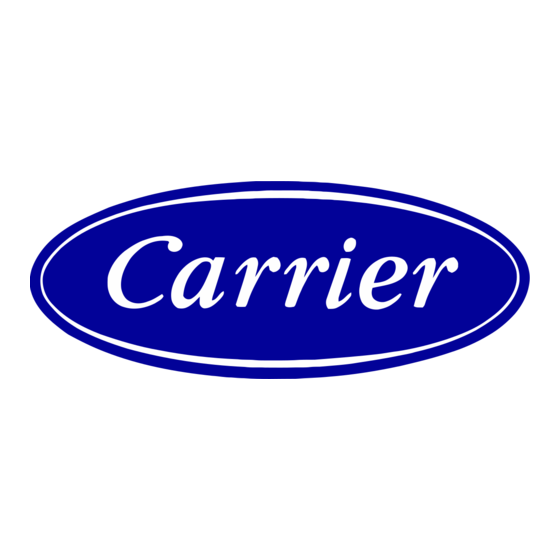

Carrier 38QB Installation, Start-Up And Service Instructions Manual
Hide thumbs
Also See for 38QB:
- Installation, start-up and service instructions manual (20 pages) ,
- Installation manual (18 pages) ,
- Product information manual (8 pages)
Advertisement
Quick Links
Number One
XvMv*!
X\v>.vX-V'.\v^U
Xv.v\OivX 'vvl'Nv! X*.vXvX\v
Air Conditioning
_ -V
s'
<
S*
Maker
;.v.\v .* .v
v2* si
\ v
-Cv
v. \# w . ,y
v.*
<
. v.y. fv,y.\
. ly .yXyXyXyXyly.v.vX* .•.*.y.\yX%y.sy.s£X**yX£;y* **••.;>
'*. •>
y.*»
^ s w v
"•
'•*' v
'
^
-7
o
^ -
y;
a
'" v'
s
Division of
Carrier Coiporation
Carrier Parkway • Syracuse NY 13221
Heat Pump — Outdoor Section
INDEX
Page
INSTALLATION.
1-7
Step 1 — Check Equipment and Jobsite .
I
• UNPACKAGE UNIT
• INSPECT EQUIPMENT
• COMPLETE OR CONSIDER SYSTEM
REQUIREMENTS
Step 2 — Mount Outdoor Heat Pump ..
3
• ON THE GROUND: MOUNT UNIT
ON A SOLID, LEVEL CONCRETE
PAD
• ON THE ROOF: MOUNT UNIT ON
A LEVEL PLATFORM OR FRAME
Step 3 — Make Piping Connections_ 3-5
• REPLACE THE ACCURATER™ RE¬
FRIGERANT CONTROL PISTON IN
THE INDOOR COIL AS REQUIRED
• CONNECT REFRIGERANT LINES
Step 4 — Make Electrical Connections .. 5-7
• INSTALL A BRANCH CIRCUIT
DISCONNECT PER NEC
• ROUTE LINE POWER LEADS
INTO UNIT
• CONNECT GROUND LEAD AND
POWER WIRING
• SEE INDOOR UNIT AND ELECTRIC
HEATER INSTALLATION, START-UP
AND SERVICE INSTRUCTIONS
• CONNECT CONTROL POWER
WIRING (24 v)
i
START-UP.
7
SERVICE. 7-14
MAINTENANCE. 14-17
SAFETY CONSIDERATIONS
Installation and servicing of air conditioning
equipment can be hazardous due to system pres¬
sure and electrical components. Only trained and
qualified service personnel should install, repair or
service air conditioning equipment.
Untrained personnel can perform basic main¬
tenance functions of cleaning coils and cleaning
and replacing filters. All other operations should be
performed by trained service personnel. When
working on air conditioning equipment, observe
precautions in the literature, tags and labels attached
to the unit and other safety precautions that may
apply.
Follow all safety codes. Wear safety glasses and
work gloves. Use quenching cloth for brazing oper¬
ations. Have fire extinguisher available for all
brazing operations.
WARNING; Before performing service or
maintenance operations on system, turn off
main power switches to indoor unit and out¬
door an^
heater power
switch if applicable. Electrical shock could cause
personal injury.
INSTALLATION
Step 1 — Check Equipment and Jobsite
UNPACKAGE UNIT — Move to final location.
Lift carton off, taking special care not to damage
service valves or grilles.
INSPECT EQUIPMENT — File claim with ship¬
ping company if shipment is damaged or incomplete.
COMPLETE OR CONSIDER SYSTEM RE¬
QUIREMENTS before installing the 38QB:
Consult local building codes and National
Electrical Code (NEC) for special installation
requirements.
When installing, allow sufficient space for
airflow clearance, wiring, refrigerant piping and
servicing. Position so water or ice from roof cannot
drop directly on top of unit.
Make provisions for condensate drainage and
defrost water disposal whether unit is installed on
ground or roof. (Ensure unit basepan drainage
holes are not blocked.) See Step 2 for details. Roof
installation method for 38QB depends on building
construction and special requirements of local
codes. Be sure that roof can support unit weight.
It is recommended that 38QB units be used with
Carrier approved indoor sections; see Table 1.
System Refrigerant Control on 38QB units and
matching Carrier indoor units is a factory-installed
AccuRater™ device (bypass type). Bypass-type
AccuRater components are discussed in the service
section of this booklet. The AccuRater piston has a
refrigerant metering hole thru it and is field replace¬
able. Table 2 indicates indoor units for which the
© Carrier Corporation 1982
Form 38Q8-1 SIM
Advertisement




Need help?
Do you have a question about the 38QB and is the answer not in the manual?
Questions and answers